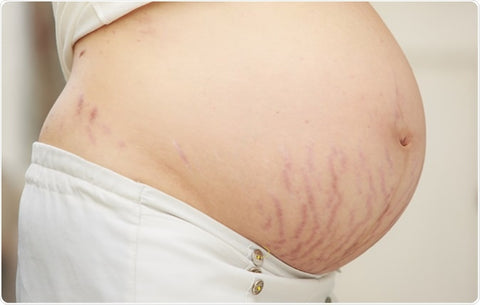All The Colors Of Stretch Marks & How To Treat Them

Do you have stretch marks?
We’re talking about the kind of stretch marks that appear on your belly, thighs, and breasts during pregnancy. The ones that are red or purple in color. The ones that can be painful to touch and make you feel self-conscious when wearing a bathing suit.
Stretch marks are a fact of life, especially for women. It’s estimated that 90 percent of all women will develop stretch marks during their lifetime.
Some people have just one or two while others can have hundreds. Stretch marks come in different colors and sizes, but they usually look like thin streaks or lines on the skin. They may be red, purple or white. However, most often they are pinkish-white to light brown with fine reddish-brown streaks running through them (called striae rubra).
You don’t have to live with these embarrassing scars any longer! Silicone Fusion™ is clinically proven to reduce the appearance of stretch marks by up to 90% in just 1 hour! It also helps prevent new stretch marks from forming while helping existing ones fade away over time.
Click this link now for more information on how you can get rid of your unsightly stretch marks today

Location: Stretch marks can occur almost anywhere on the body, but most commonly occur on places like the stomach, hips, thighs, breasts, arms, and even places like around the knees or lower back. Someone may have stretch marks in just one of these locations, or in multiple locations.
Cause: There are a few key causes of stretch marks. Because stretch marks occur due to the skin not being able to expand as quickly as other parts of the body, the main cause is growth. This growth can be due to pregnancy, when the abdomen expands to accommodate a growing fetus, or to puberty, when growth spurts cause a young person to grow rapidly. Additionally, weight gain and weight loss can contribute to stretch mark formation. Though it may seem unusual to get stretch marks when you lose weight, it's the fluctuation of weight and collagen loss that can cause stretch marks to occur.
Conclusion
Stretch marks are an unfortunate side effect of pregnancy and weight gain.
We all know that stretch marks aren't a good look, but they can also cause itchiness and leave you feeling sore. Stretch Marks can make you feel self conscious about wearing your favorite clothes or even going to the beach. You may have tried other products in the past, only to be disappointed when nothing happened…
The Enhanced Silicone Fusion™ System is clinically proven safe for both mom and baby during pregnancy. There is no need to worry about using it while pregnant. It works by increasing collagen production under the skin's surface. This helps improve elasticity and reduce scar tissue formation. This means less visible scars after just 1 hour of use!
Click here to checkout our Enhanced Silicone Fusion™ System
For more information on how to treat stretch marks, visit Dermaclara.com.



